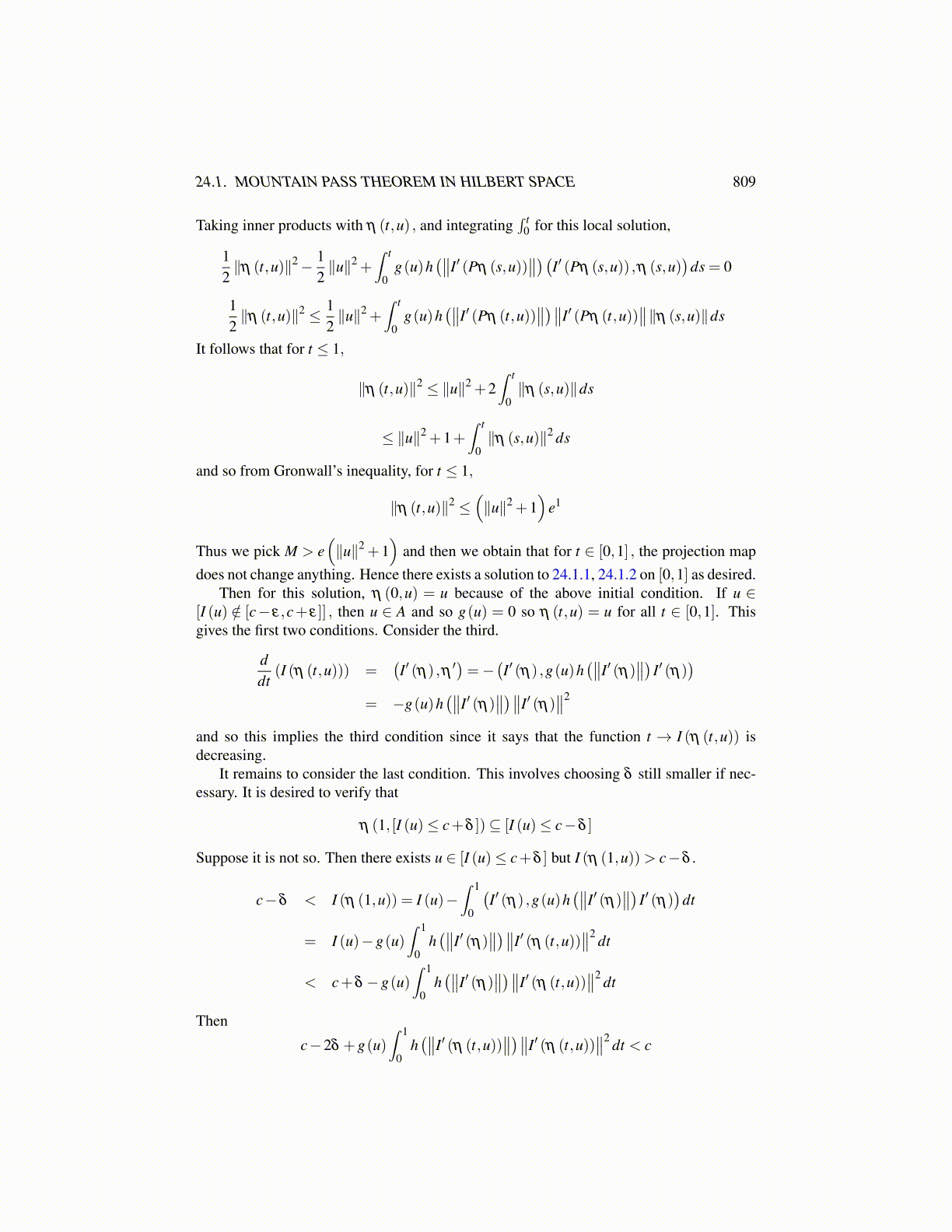
24.1. MOUNTAIN PASS THEOREM IN HILBERT SPACE 809
Taking inner products with η (t,u) , and integrating∫ t
0 for this local solution,
12∥η (t,u)∥2− 1
2∥u∥2 +
∫ t
0g(u)h
(∥∥I′ (Pη (s,u))∥∥)(I′ (Pη (s,u)) ,η (s,u)
)ds = 0
12∥η (t,u)∥2 ≤ 1
2∥u∥2 +
∫ t
0g(u)h
(∥∥I′ (Pη (t,u))∥∥)∥∥I′ (Pη (t,u))
∥∥∥η (s,u)∥ds
It follows that for t ≤ 1,
∥η (t,u)∥2 ≤ ∥u∥2 +2∫ t
0∥η (s,u)∥ds
≤ ∥u∥2 +1+∫ t
0∥η (s,u)∥2 ds
and so from Gronwall’s inequality, for t ≤ 1,
∥η (t,u)∥2 ≤(∥u∥2 +1
)e1
Thus we pick M > e(∥u∥2 +1
)and then we obtain that for t ∈ [0,1] , the projection map
does not change anything. Hence there exists a solution to 24.1.1, 24.1.2 on [0,1] as desired.Then for this solution, η (0,u) = u because of the above initial condition. If u ∈
[I (u) /∈ [c− ε,c+ ε]] , then u ∈ A and so g(u) = 0 so η (t,u) = u for all t ∈ [0,1]. Thisgives the first two conditions. Consider the third.
ddt
(I (η (t,u))) =(I′ (η) ,η ′
)=−
(I′ (η) ,g(u)h
(∥∥I′ (η)∥∥) I′ (η)
)= −g(u)h
(∥∥I′ (η)∥∥)∥∥I′ (η)
∥∥2
and so this implies the third condition since it says that the function t → I (η (t,u)) isdecreasing.
It remains to consider the last condition. This involves choosing δ still smaller if nec-essary. It is desired to verify that
η (1, [I (u)≤ c+δ ])⊆ [I (u)≤ c−δ ]
Suppose it is not so. Then there exists u ∈ [I (u)≤ c+δ ] but I (η (1,u))> c−δ .
c−δ < I (η (1,u)) = I (u)−∫ 1
0
(I′ (η) ,g(u)h
(∥∥I′ (η)∥∥) I′ (η)
)dt
= I (u)−g(u)∫ 1
0h(∥∥I′ (η)
∥∥)∥∥I′ (η (t,u))∥∥2 dt
< c+δ −g(u)∫ 1
0h(∥∥I′ (η)
∥∥)∥∥I′ (η (t,u))∥∥2 dt
Then
c−2δ +g(u)∫ 1
0h(∥∥I′ (η (t,u))
∥∥)∥∥I′ (η (t,u))∥∥2 dt < c